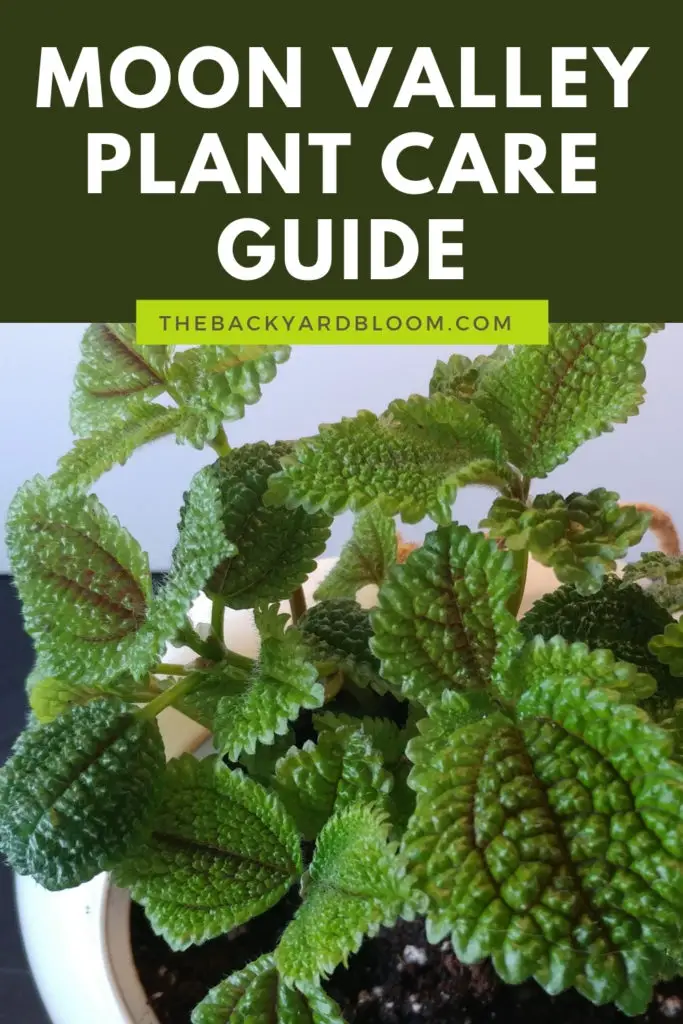Please note that this post may contain affiliate links. You can read my full affiliate disclosure at the bottom of the page.
Pilea Moon Valley plants have one of the most interesting and beautiful textures of any house plant I’ve ever seen. The rough valley-like texture of its leaves makes it stand out.
They are a mounding plant and don’t get too big. Most of the time the Moon Valley Friendship plant will only get to be about 12 inches in height. But if left in a hanging basket they can start to trail. Ours currently is about 10 inches above the pot and then about 2 feet of trailing foliage coming out of the top.
- Pilea Mollis Origins
- How To Water a Pilea Moon Valley Plant
- Pilea Moon Valley Friendship Plant Light Requirements
- Pilea Moon Valley Friendship Plant Soil
- How To Repot Moon Valley Plants
- Fertilizing Moon Valley Plants
- Temperature
- Humidity
- Pruning
- Moon Valley Plant Propagation
- Pilea Moon Valley Plant Toxicity
- Common Moon Valley Pilea Problems
- Frequently Asked Questions About Pilea Moon Valley Plants
Find other houseplant care guides here.
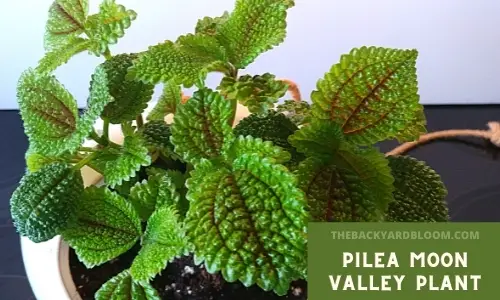
Pilea Mollis Origins
Its scientific name is Pilea involucrata and it originally comes from South America and Central America. This is one of the genus of 100s of species of Pileas.
Its common name Moon Valley was given to this plant because of the ridges and crevices that are all over its foliage.
Other Names for Moon Valley Friendship Plants
- Friendship Plant
- Honeymoon Valley Friendship Plant
- Pilea Mollis
- Moon Valley Panamiga
- Moon Valley Plant
- Pilea involucrata Moon Valley
How To Water a Pilea Moon Valley Plant
You don’t want to keep the soil moist all the time. Moon Valley plants can be prone to root rot so always make sure to let the soil dry between watering your plant.
They do prefer evenly moist soil just not constantly wet soil. Water the plant only after the top surface layer of the soil is dry.
If the soil dries out and you see that the foliage of the plant starts to wilt then you will want to make sure to water the plant evenly and perhaps lessen the time between waterings a day or two depending on how the soil feels.
Check out our Pilea Moon Valley Watering Guide for more details on how to water your plant.
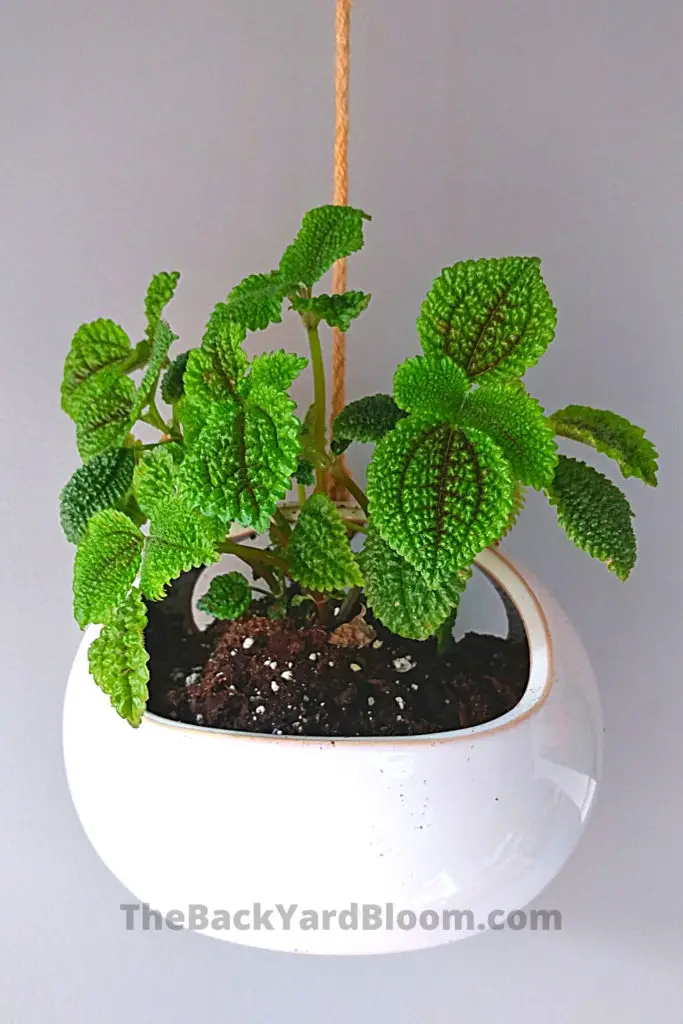
Pilea Moon Valley Friendship Plant Light Requirements
These plants like bright indirect light. They can not handle direct sunlight well.
Putting this plant in direct sunlight can burn the foliage.
One of the most common issues people run into with Moon Valley is that when they are sold in places like Lowes or Home Depot the care card says the plant likes low light. When putting these in areas that are low light the plant will start to drop leaves and eventually die if you stick to the directions on the care cards.
I managed to off my first Moon Valley because I followed the directions from Lowes.
I now have my current Pilea hanging near an eastern-facing floor-to-ceiling window where it gets plenty of indirect bright light throughout the day and it is loving it there.
Pilea Moon Valley Friendship Plant Soil
Use a peat moss based soil mix when potting your Moon valley plant. If making your own potting mix make sure to add perlite to allow for aeration and drainage. (What is perlite?)
Make sure that the soil mix is well-draining. A soil mix that doesn’t drain well can lead to root rot.
If you like to use premixed soil some common suggestions for Moon Valley plants are to use 2 parts regular potting soil with 1 part succulent soil and add a bit more perlite to the mixture. The second most popular soil for these is African Violet soil.
How To Repot Moon Valley Plants
It is best to repot your Moon Valley during the springtime, preferably during the early spring to mid-spring season. This allows it to recover easily from the shock of repotting.
They have shallow roots and should only require repotting every couple of years.
You will know it is time to repot your plant if you see roots coming out of the drainage holes of the pot or you see them appearing in the top of the soil. Another indication that it might need repotting is if you are noticing it is needing more water than usual or the soil isn’t draining well anymore.
When picking out a pot for your plant make sure to pick one that has drainage holes. For size get a pot that is only a couple of inches bigger than its current pot.
Root rot can be a common issue with Moon Valley so drainage is one of the most important things with these plants.
When repotting your Moon Valley make sure to get as much old soil off the roots as you can. Take this time to inspect the roots and remove any dead or damaged roots with a sterilized cutting tool.
Fertilizing Moon Valley Plants
Using a liquid-based fertilizer is best for Pilea Moon Valley plants. Dilute it to 50% of the dose and fertilize once in the spring and again in the summer.
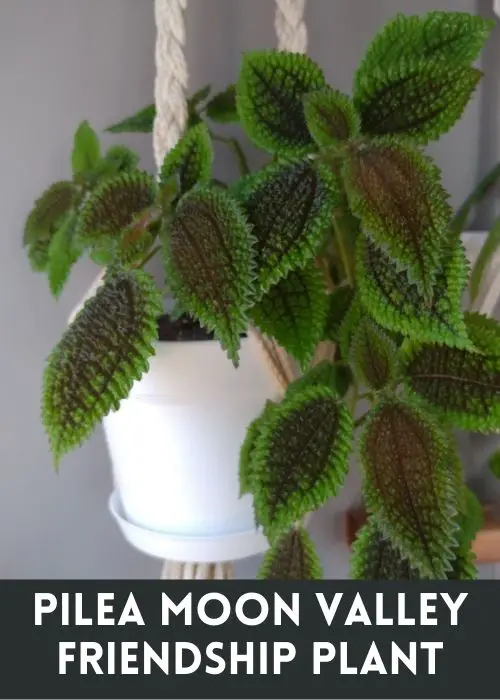
Temperature
These plants like warmer temperatures. Usually between 65 degrees Fahrenheit and 80 degrees Fahrenheit.
Don’t put your plant in drafty places like near an air vent or where open windows or doors can let in air when it’s too hot or too cold.
Humidity
Moon Valley plants are native to Central and South America so they prefer higher humidity levels. They do best with humidity above 50%.
Many people like to use a humidity meter just so they can be sure of the humidity levels for their Moon Valley plant. Too dry of air can cause issues with the leaves starting to turn brown.
To help keep the humidity above 50% some people find using a humidifier for the area to be a great option.
Pruning
Sometimes, depending on the light levels, Moon Valley plants can get leggy.
You can cut or pinch back leggy growth on these plants and that will help it stay compact and bushy.
Moon Valley Plant Propagation
You can propagate these plants easily by placing stem cuttings in water and roots will start to grow.
After roots appear on the stem cutting place them in soil and keep the soil moist so the plant can establish its root system.
Pilea Moon Valley Plant Toxicity
Moon Valley plants are not toxic to dogs or cats.
If you find that your cat likes to munch on the leaves of your plant you can use Bitter Apple or a homemade citrus spray made from lemon juice to make them not as appealing to chew on.
Common Moon Valley Pilea Problems
Root Rot
Root rot is common with Moon Valley plants. Because they like more moist conditions often people over water and allow the plant to sit in soggy soil.
Make sure to have well-draining soil and a container that allows for drainage of the soil.
Also make sure to check the soil moisture levels, let the top surface layer dry out before watering again.
Droopy Leaves
For a more detailed look at why your Pilea might have droopy leaves see our article, Why Is My Pilea Moon Valley Drooping?
This problem could be due to either the soil is being kept too soggy or the soil is staying dry too long.
It is best to test the moisture level of your soil by either using your fingers or you can use a moisture meter to see which issue it might be causing the leaves to droop.
Brown Tips on Leaves
Moon Valley leaves getting brown tips can be caused by not enough humidity in the air.
Humidity levels for these plants should be at least 50%.
Brown tips can often lead to the entire leaf turning brown. If you are noticing this see our article Why Are My Pilea Moon Valley Leaves Turning Brown? to help figure out what might be going on with your Pilea Moon Valley.
Pests
While these plants are usually resistant to pests, there can be times where aphids, fungus gnats, mealybugs, or spider mites become an issue.
Fungus Gnats
These are small little black flies that you can often see moving on the soil surface and flying around close by. They will also spin webs on the surface of the soil that can look like spider webs.
The best way to control these pests is to reduce the water amount that you use when watering your moon valley plant.
You will also want to use a way to trap the adults flying around your plant so they can’t lay more eggs. There are sticky traps you can place in your plant pot to trap these.
Mealybugs
Mealybugs are little white fluffy-looking bugs that like to hang out on the joints of the plant stem.
To control these the easiest option is to use an insecticidal soap.
Another way people try to control these is by using rubbing alcohol and a Qtip to take them off of the plant. I’ve never been able to stay ahead of an infestation this way though.
Aphids
Aphids are a pain in the butt for any plant lover.
To get rid of these pests insecticidal soap or neem oil work best.
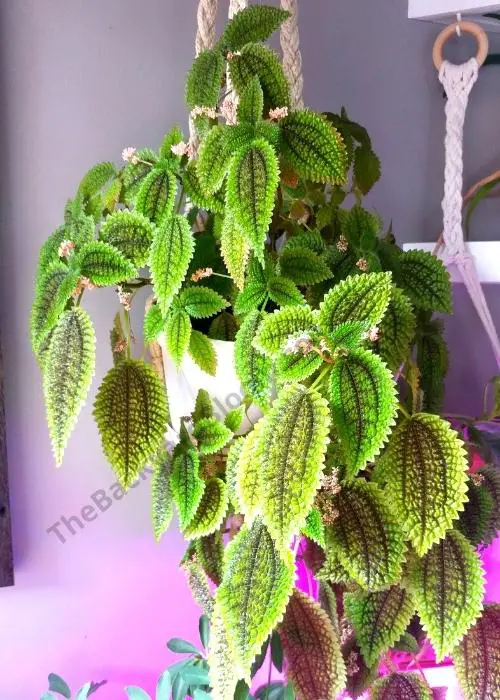
Frequently Asked Questions About Pilea Moon Valley Plants
Moon Valley Friendship plants grow to about 1 foot tall. If you start to see it looking leggy you can pinch back taller growth to make it more compact and bushy. If allowed to, they will trail if grown in a hanging plant pot and will grow longer than 12 inches.
Pilea Moon Valley plants do get small pale pink flowers, usually during the summertime.
No, you should not mist a Pilea Moon Valley plant. Due to the crevices in the leaves, moisture can stay on the leaves when it gets misted and cause damage and rot to the leaves. If low humidity is getting to be an issue get a humidifier for the area that you have your plant to help raise the humidity in the area.
No, the Pilea Moon Valley plant is not poisonous to cats or dogs. This is one of those houseplants that is safe to have if you have pets in the house.
Pin This for Later:
